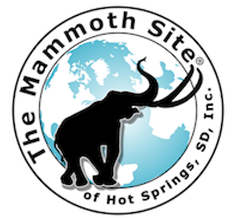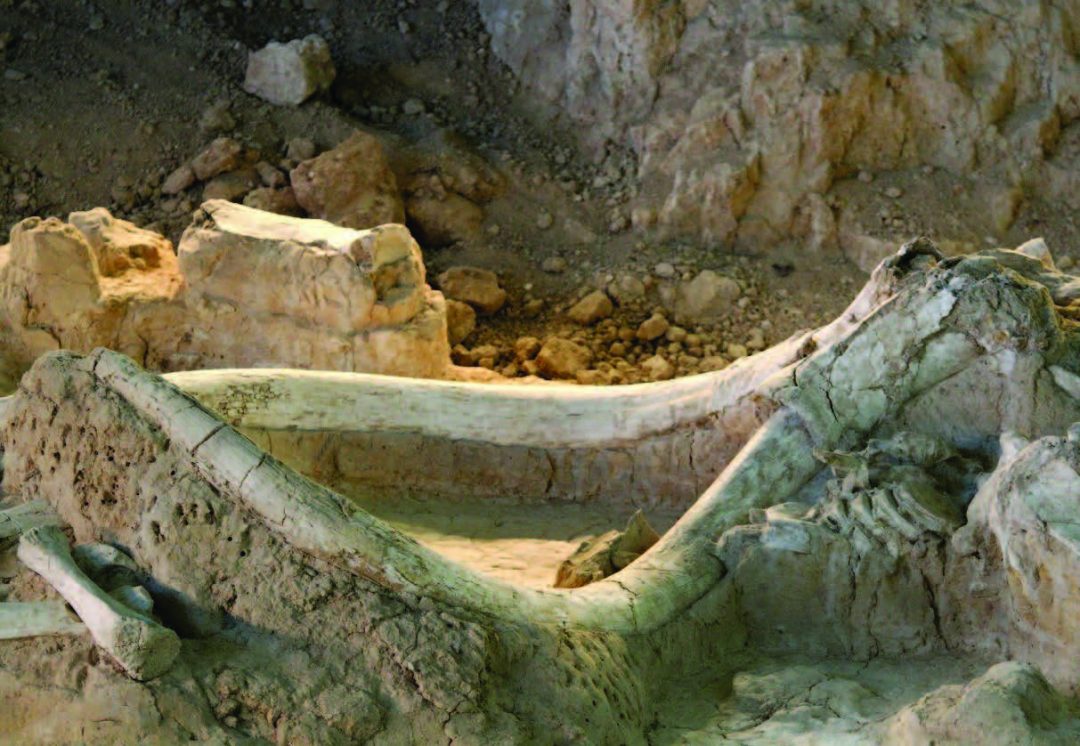Jim I. Mead, Justin S. Tweet, Vincent L. Santucci, Jeffrey T. Rasic, and Sharon E. Holte

Abstract – Proboscideans (Mammalia, Proboscidea) are an ubiquitous part of North American ver-tebrate faunas throughout the Miocene, Pliocene, and Pleistocene. Here we discuss the fossil record of proboscideans found on public lands administered by the National Park Service (NPS), which is comprised of 419 units. At least 276 of these units contain some aspect of fossil heritage for the USA. We present 63 NPS units and affiliated areas that have records documenting fossil proboscideans. The geological and paleoecological diversity preserved and represented in these 63 units record fossils from Arctic to tropical and steppe to rainforest environments. This is an invaluable data set that has yet to be fully recognized. The information presented here, much of which has not been published, is intended as a compilation to support researchers.
Introduction
Since 1916, the National Park Service (NPS, US Department of the Interior) has been entrusted with the care of our national parks, and as their mission, they are to preserve un-impaired the natural and cultural resources. The official emblem contains the arrowhead, mountains, Sequoia tree, and bison which represent aspects of our natural and cultural re-sources and exemplify the overall mission. The National Park System covers more than 85 million acres and is comprised of 419 sites with at least 19 different designations, including 130 historical units, 87 monuments, 61 national parks along with a number of other types of units. In addition, the NPS recognizes, but does not manage, National Natural Landmarks (NNL), National Historic Landmarks (NHL), and other affiliated sites. These preserved and recognized localities represent a significant expanse of geographic area of the USA and em-body a tremendous aggregate of natural and cultural heritage to conserve and understand. The geological and paleoecological diversity preserved in these lands and represented in their fossil record (from Arctic to tropical, and steppe to rainforest) is noteworthy and an invaluable data set that has yet to be fully recognized and understood (see overview about fossils on federal lands in Liggett et al. 2018).
On March 30th, 2009 President Barack Obama signed the Paleontological Resource Pres-ervation Act into law authorizing five federal land managing agencies, including the NPS, to understand, preserve, and conserve their fossil resources (see discussion in Santucci 2017). At least 276 NPS units contain some aspect of our fossil heritage. Here we concentrate on the vertebrate resources preserved or recognized by our nation’s National Park System (ad-ministrated and affiliated) and focus on one iconic group of mega-mammals, the probosci-deans. To help better understand the evolution of Proboscidea in North America, we provide
1The Mammoth Site, 1800 Hwy 18 ByPass, Hot Springs, SD 57747; Desert Laboratory on Tumamoc Hill, University of Arizona, Tucson, AZ 85745; and East Tennessee State University Natural History Museum, Johnson City, TN 37614, jmead@mammothsite.org; 928-853-6393. 2National Park Service, 9149 79th Street South, Cottage Grove, MN 55016, justin_tweet@nps.gov. 3National Park Service, Geologic Resources Division, 1849 “C” Street, Washington, DC, 20240, vincent_santucci@nps.gov. 4National Park Service, Gates of the Arctic National Park and Preserve, and Yukon-Charley rivers National Preserve, 4175 Geist Road, Fairbanks, AK 99709. 5The Mammoth Site, 1800 Hwy 18 ByPass, Hot Springs, SD 57747, sharonh@mammothsite.org. *Corresponding author: jmead@mammothsite.org.
Here in one outlet a sometimes hard-to-assemble resource for researchers and interested public who want to further understand these mammals from all NPS and affiliated lands (Fig. 1). Proboscideans are found as fossils throughout the continent, both east and west of the Mississippi River. Our approach is to view the distribution of fossil proboscideans from NPS administered and affiliated lands (from here on collectively referred to as NPS Units) on a continental-wide scope. The information presented here is intended as a compilation to support researchers, to provide a preliminary examination of the holdings on NPS Units so that more detailed studies can be planned. It is not our intent to present all the actual data in any detailed account, but do indicate which NPS Units contain proboscidean remains. Information about these remains is not always published or readily available to researchers. We also present in a historiographic approach the discovery, recovery, and issues associated with these remains. We hope that this document will help spur further analyses into better understanding this often poorly understood group of land mammals.
Proboscideans
Proboscideans (Mammalia, Proboscidea) are a ubiquitous part of North American vertebrate faunas throughout the Miocene, Pliocene, and Pleistocene. There were still members of three families in greater North America during their waning phase in the late Pleistocene: Gomphotheriidae (Gomphotheres), Mammutidae (Mastodonts), and El-ephantidae (Mammoths).
The phylogenetic understanding of Proboscidea is almost purely based upon the pale-ontological record (Shoshani and Tassy 2005, Tassy 1996). Indigenous proboscideans in North America have been extinct since the end of the Rancholabrean North American Land
Mammal Age (LMA; end of the late Pleistocene) and the beginning of the Holocene. The precise timing and the ultimate cause(s) of the extinction are still hotly debated and heavily scrutinized. The intent here is not to assess the extinction cause or its finalization.
Proboscideans were the largest land mammals in North America during the late Ceno-zoic. They originated in the Paleocene in northern Africa and southern Asia along the Tethys Sea (Lambert and Shoshani 1998). At approximately 16 Ma (Barstovian LMA, Ba1), the arrival of Zygolophodon (Vacek 1877; Mammutidae) in North America marks the Probosci-dean Datum. By 17–15 Ma North America was experiencing the Middle Miocene Climatic Optimum which permitted a rich, warm temperate mixed mesophytic forest with numerous conifers over much of the northern continent and the incipient spread of grasslands. The woodland-grasslands of the Great Plains region of today graded west into a montane conif-erous forest and mixed mesophytic deciduous forest biome (see discussion in Woodburne 2004). At approximately 15 Ma the continental climate began to deteriorate into a cooling trend—a possible response to a global shift in the oceanic circulation likely caused by a major expansion of the East Antarctic Ice Sheet (Flower and Kennett 1993). By the late Barstovian (Ba2, ~14.6 Ma) the first arrival of Gomphotheriidae occurred in the Western Hemisphere (Tedford et al. 2004).
During the remaining Miocene and through the Pliocene, Proboscidea of North America included numerous members within two families: Mammutidae and Gomphotheriidae (see discussions in Lambert 1996, Saunders 1996, Shoshani and Tassy 2005). These probosci-deans promptly dispersed across North America and ultimately south into South America during the Great American Biotic Interchange of the late Pliocene (Blancan LMA). Climate continued cooling through the Pliocene culminating in the Pleistocene (beginning ca. 2.58 Ma), defined by its multitude of glacial maxima (20+), interglacial warm episodes, faunal dispersals, and evolutionary developments. The first occurrence of Elephantidae in North America during the early Pleistocene marks the beginning of the Irvingtonian LMA with the arrival of the Elephantidae, Mammuthus (Brookes 1828). The current and most conserva-tive estimate for the oldest Mammuthus in North America is 1.3 Ma. However, the earliest arrival date is still debated (see discussion in Bell et al. 2004).
Proboscideans and our National Park System
Sixty-three NPS Units have a record of proboscideans (Table 1), although not all speci-mens have been placed into a retrievable numerical dataset system. The summary below provides a synopsis about each park unit or affiliated site and the proboscidean remains that are known from or are curated for the locality. The number accompanying the NPS Unit listed below (text and Table 1) refers to the location on Figure 1. The great majority of NPS proboscidean records are from the late Pleistocene. Specimens diagnostic to the species level are almost all Mammut americanum (Kerr 1792 fide Osborn 1936, American mastodon; although see below Mammut pacificus, Dooley et al. 2019, Pacific mastodon), Mammuthus columbi (Falconer 1857, Columbian mammoth), or Mammuthus primigenius (Blumenbach 1799, Woolly mammoth). Many of the specimens have been only provision-ally identified. Specific and authoritative taxonomic identifications should be reassessed and studied in more detail. Researchers interested in viewing fossils referred to below should contact the park unit manager even though the actual specimens may be cataloged off-site at a nearby institution or regional repository, and in some cases widely distributed across the USA. The NPS requires that all recovery of fossil specimens be undertaken through an approved research and collecting permit.

